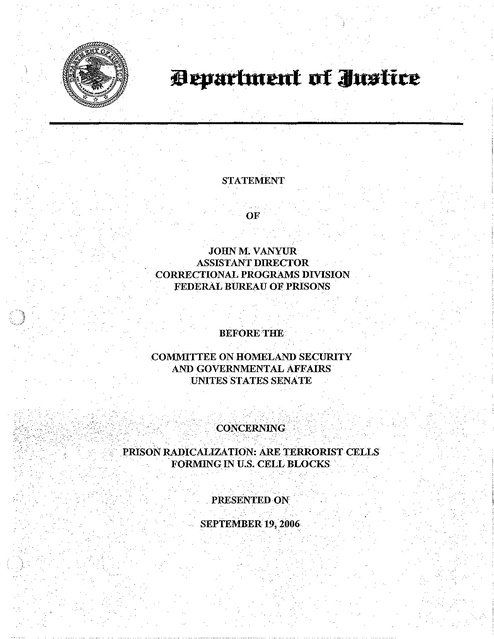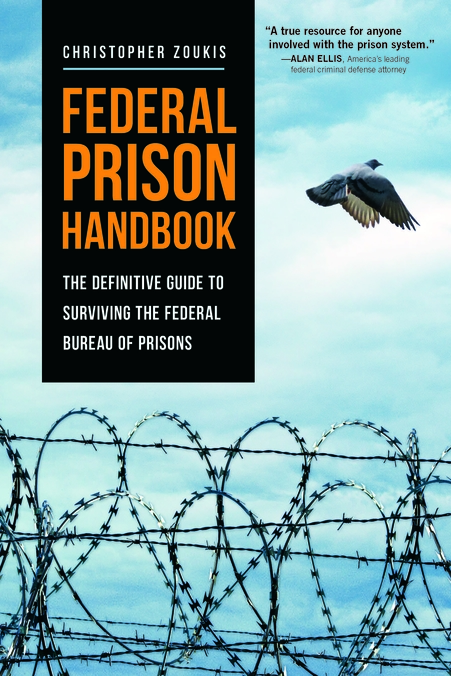Usdoj Vanyur Statement Re Prison Radicalization Are Terrorist Cells Forming in Us Cell Blocks 2006
Download original document:

Document text

Document text
This text is machine-read, and may contain errors. Check the original document to verify accuracy.
STATEMENT
OF
JOHN M. VANYOR
ASSISTANT DIRECTOR
CORRECTIONAL PROGRAMS DIVISION
FEDERAL BUREAU OF PRISONS
BEFORE THE·
COMMITTEE ON HOMELAND SECURITY
AND·GOVERNMENTAL AFFAIRS
UNITES STATES SENATE
.
..
CQNCERNING i ••.. . ..
PRISON RADICALIZATION: rnTERRORIST CELLS
FORMING IN U.S. CELL BLOCKS·· .
. "
"
"."
. PRESENTEDON .....
SEPTEMBER 19,.200~ .
STATEMENT OF JOHN M. VANYUR
ASSISTANT DIRECTOR, CORRECTIONAL PROGRAMS DIVISION
FEDERAL BUREAU OF PRISONS
BEFORE THE
COMMITTEE ON. HOMELAND SECURITY
AND GOVERNMENTAL AFFAIRS
September 19, 2006
Chairman Collins .andMembers of the Committee:
I am.pleasedto appear before you tbdayto discuss the efforts
the Bureau of Prisons is taking to ensure we are pr~ventirig the
recruitment of terrorists and extremists in our Feciera1 prisons .
. Of the roughly 2.2 million incarcerated persons in the United
States, the Buieau ofPiisons (BOP) is respons{~l~ for the
custody and care of 192,000 inmates confined in 113 Federal
prisons and in facilities operated by private companies and by
State and ·local·governments.
Our mission is to protect society
by confining offerid~rsin the controlled environments of prisons
"andcommunity-based faci:litiesthat are safe> hUIl1:~ne, 'cost.....
: .. '
.
'eiii61erif),·a~ci.~ppropil~tei:y
secui~;and topr6vide . work
.....
;
and
. 6tl1erseif~impiQvement opportunit.ies toas$ist offenders ·in
becominglaw-~biding·citizeris.
The·BOP is cOmIn:i,ttedto providing inmate$ wi ththeopportunl.ty to
pia~ti~e'theirfaith while
at the same time. ensuring that Federal
1
prisoners p're not radicalize,d or recruited for terrorist ca_uses.
The support that has been provided by the FBI,- the agencies
represented on the National Joint Terrorism Task Force (NJTTF),
other components of ,the Department-of Justice, and many other
members of the law enforcement and"intelligence communities has
,been invaluable in our efforts in this area.
:Wellricterstand the" importance of controlling and, preventing the
."
.:.'
'
.
.'.
.
.
recruitment of, ininate~into terrorism.
We also acknow'lectgethat
-this is an evolving issue, especially as it relates to the
-relationshipsbet'1een terrorism, certain-radical or extremist
.
. ,
ideologies, and the penchant of those who adhere to these
-ideologies to recruit others to their positions.
-
,
We know that inmates are particularly vulnerable to radical
recruitment and-we must guard against the spread-of terrorism and
extremist ideologies.
'"
:
Our practices in institution security arid
-
-:irlIU9-,te managementa,regearedtowarcl the preventionof:any _
.
.:,
.
r·~~1~_tenf~f_--<?rittlin1:1_bella.viqi,--dlsruPti ve '~~havior,_>Or qther -_:th-J:'~a:is to: in~titutio~security or pUblic safety, includlngthe
:__
:.
.
"- : radicalization of ,- inmates.
-
'
-
Over the last several years, our agency has taken a number of'
-s{gnifi~an:tmeasures, and
we are activelyengag-ed in several
ongoing initiatives to ensure that Federal inmates are not __
recruited to support radical Drgartizations or terrorist groups.
For example, we have eliminated most inmate organizations in
order to control the influence that outside entities have on
Federal inmates.
We also have enhanced our information arid
monitoring systems, our intelligence gathering and sharing
capabilities, and our identificatiOn and management of disruptive
. inmates.
For over a decade, we have been managing inmates determined to
. have ties to terrorism by confining therp in secure conditions and
by closely monitoring their communications.
We have established
.a strategy that focuses on· the appropriate levels of' containment.
. and isolation to ensure that inmates with terrorist ties do. not
have'the opportunityt.o radicalize or recruit other inmates .
. AII inmates determined to have terrorist ties are clearly
ident~fieqand.trackedin our :information systems.
.... ,....
·\:'da:hg.-e~~usierr()ri.stsare
..
:"
:..... -
'-'"
.
"':'"
'..' :::'66riditions
. -'
...
"
.
'.
":
The most
..
c6nfined
und.er·· the most~est;ictive'
.
.'
.
-'.
allo~ed, .' ~nd' many of these'
inmates are house.d in our-.
".
.
.
",
.
.
,"
'
' .
inostsecurefacility, the Administrative Maximlim United States
"'Penitentiary in Florence, Colorado ~
3
'We' moni tor: and record all telephone communication (except
attorney-client conversations) involving inmates with terrorist
ties and, following established procedures, we share any relevant
'information with the FBI, the NJTTF, and o,ther agencies.
In
addition, our institutions work closely with the local Joint
Terrorism Task Forces (JTTF) to share information and
intelligen6e about these inmates.
, The,Bureau has worked diligently, particularly since 9/11, to
enhance our intelligence gathering and sharing capabilities in
order to ensure a seamless flow of intelligence informati,on
.
'
.
.
'between our agency' and' other law enforcement ,and counter~terrorism agencies.
,We have two full-time employees assigned to
the NJTTF to facilitate our involvement on thlstask 'force and 1:0
coordinate the exchange of intelligence related to corrections.
These two members of the NJTTF also manage the Correctional
"Tntell:i:gence Tili tiativ,e{CIT), a
"'
nationwide 'N:JTTFs:pecial project
':,irt;6i~ing:correctional, agencies,at the'Fede~al,Sta~e~andl0caT
:.';
'-.
",
- ' ..
"
.
'.
,"..
.
"te'vel~,de'signedto' detect, deter, and disrupt the ' radicali.zation
ancibecruitlng of inmates .
This initiative involves .training O'f'
"dorrectfohal administrators by eadh 10CalJ;TFFexcharige Of
. inteLLigence; communicating best practlces to "local JTTFs in: '
'orciEkrto detect, deter, and disrupt radicalization; and
4
coordinatien of liaison and intelligence'--sharing activities-between local JTTFsand corrections agencies.
Most importantiy,throughthe ell, intelligence regarding any
attempts by inmates, religious providers, or others to radicalize
any segment of the population is gathered and shared, and
appropriate interdiction action is taken by the proper
,
'
cbrr$Gtional~uthority.
In
addition to containing and isolating inrnates who couldatterript,
to radlca1.ize other inmates, we help inmates become less
vulnerable to any such attempts.
Experts have identified, the societal marginalization of inmates
as a key factor in their becomingr'adicalized.
The Bureau of
Prisons provides inmates with a broad variety of programs that
have been proven to as'sist in the development of key skills,
',thel:'eby minimizing the likelihood of the inmates, being
. .:
".
.~::.
.'
~~i'g~naiize~:i.~'
. .
,".
'. '
.....:
. -:~.
'.'.~'
:::
.
'.-'
Thei·p~ogTams
.
;".'
we provide include work in prison industries and
. other ',insti tution" johs"
vo~ational't~~ining, education," sUbs~ance
.: .... :..
.
.....
,,':
....
:.,
::.
'abuse}.:i::'eatment, r.eligiousprog~ams, and other skills-building
and pro'--sociaivaluesprograms.
.
Moreover ,we are well aware of the important role religious __
programs can play in preparing inmates to successfully
reintegrate into society following release from prison.
Religious programs and chaplaincy services are provided to the
approximately30 faiths represented within the Federal prison
population.
Within the constraints of security, we provide
worship services, study of scripture and sacred writings, and
reli.giouswol;"kshops; and we make accommodations to' facilitate
observances. of holy days.
Full-time civil service chaplains in
the Bureau of Prisons lead worship services and provide pastoral
care and
spirit~alguidance to
inmates, and they oversee' the
breadth·of religious programs and monitor the accommodations
provided by contract'spiritual leaders andcommuhityvolunteers.
The overwhelming majority' of inmates participate in'religious
programs in a positive, healthy,. and productive way.
We screen· all Of our civil service staff, volunteers, .' a.nd
'".
~
\'
'-:".
,.;
.
,.
..": ",·i· ,.
'cqnt-r:act.6rs'
" .. ~:
to'av.~id, hiiingorcantracting
'.' pOse\a threat ,.toiristitutiori security.
.
.". -'. .
wi th:
'o' •
~ny()ne' who
would
Each BOPclvil service
.
chaplain must'nl'eet all the requirements. for employment as a.
F~derallawenforcem~ntofficer,.' includin.g
_:
':
criminal
ba~~groundclieck,'. reference. check,
a.
,fieidinve~tigation,
drugsc:r::eening, a
pre-.employment sllitabllity interview,· ahd a panel interview.
6
In
addition, chaplains must meet requirements unique to their
employment and the scope of their duties.
Like all BOP
8111ployees, chaplains are strictly prohibited from using their
:position to condone, support, or encourage violence or
oth~r
inappropriate behavior.
Our religious contractors and volunteers are also subject to. a
• :variety of security' requirements prior to being granted access to
the institution including: criminal background checks; law
enforcement agency checks to verify places of residence and
places of employment; a fingerprint ch~ck; gathering information
from employers from over. the previous 5 years; and drug testing.
The Bureaucontinu~s to work closely with the FBI and the NJTTF .
with regard to the screening of religious service providers.
Informatlon on staff chaplains and on contractors and volunteers
{whether the contractor or volunteer is being considered to help
providereligious<s~rvices.orriot}·is checked against,da~aba'ses
'.' · ..~uPP'bFted·
'.
',:.~"
by.\:~e,.~B:i<··w~h~~e.also·
. -':,
enhanced the
.supe~visionQf. ..
programs arid activities that take place in our chapels Qver the
rec6gnizingthe
signs()fp~te~'tial radfcalization ..
7
Chairman Collins, this concludes my formal statement.
I would be
pleased to answer any questions you or other Members of the
Corrunittee may have.
8
Fede~l Bureauof In~estigatio~ _rongressional Testimony
Page 10f5
.'
Congressional Testimony
Contact Us
Statement of
DonaldVan Duyn
Deputy Assistant Director,· Counterterrorism Division
. Federal Bureau of Investigation
.
Before the
.
Senate Committee 'on Homeland Security and
Governmental Affairs and Related Agencies
September 19, 2006
.
- Your Local FBI Office
- Overseas~Offices
- .Submit a CrimeTip
.
- Report Internet Crime
.... More.. Contacts
· Learn About Us
- Quick Facts
- What We .Investigate
-. Nat!. Security Branch
_.Information
· -Technology
·- Fingerprints & Training
·-: Laboratory Services
- Reports.& Publications
-History .
- More About Us
Get Our News
- Press Room .
· ..: E-mail Updates 1m
- News Feeds.fi .
Be Crime Smart·
- W~nted by the FBI
- More Protections
Madam Chairman, Ranking Member and members of the
committee, thank you for the opportunity to speak to you on
the issue ofprison radicalization in the United .States.
Top. Story
Recent Stories
National Press Rl
TopLocal News
Local News by 0
Congressional
Testimony
- 2007
- 2006
- 2005
-2004
Before I begin, I would like to emphasize that Islam itself is
not the problem but rather how Islam is used by violent
extremists to inspire andjustify theiractioris. Additionally,.'
the FBI doescnofinvestigate individuals for their religious
beliefs. Rather, we investigate the activities of individuals
who want to do harm to the citizens and interests of United
States and those of our allies abroad The FBI fully
.
recognizes and is committed to protecting prisoners' civil
liberties, including religi6us rights. These activities have. led
uS to believe that prisons Gontinue to present opportunities
for. the proselytizing of both Sunni and Shia forms of radical
Islam. Moreover, domestic groups such as white
supremacists recruit in prisons as welL
- 2003
- 1002
- 2001
Major Executive
Radio
- FBI This
We~1
- Gotcha
ContactS .
- FBI Headquar
- FBI Local Offil
- 'FBIOverseas'
The U.S. Prison Environment
Backgrounders
. Use 'Our Resources
- For.Law Enforcement
·- For Communities .
.......
.... .
•;, FO[Re~~~r~~rs .
·:'More·Services:
........
.".'yisit{)urKfds" Page
"
.
FBI and the Bureau of Prisons analysis shows that
radicalization and recruitmentin U.S. prisons is still an
.". ongoing concern. Prison r~dicalizationprimarily occurs
. through:ailti;;U.S;sermonsprovidedbYcontract; volunteer.
, or:~taffimams,;radicalize9' inmates \vho gain.religious .•
· influence; and exln3rilisfmedia. ·Ideo!ogiesthat radicalized .
inmat~s appearmostoftentoembraceinclt..ideor are .
influenced by the Salafi format Sunni Islam (including '.
revisionist versions commonly known.as "prison .Islam") and .'
an eXtremistviewofShia Islam similar to that ofthe
governmentaf Itanand Lebanes(3 Hi~ballah.
.
.
. ' .
".",",".",
,"
- FBI Priorities
- FBI History .
- RepOits&Put
.- .FOIA an~~e~
Room"
.
There are two groups ofconcern irivolved in'prison .
.
radicalization and recruitment. '.'
·The first group consists of inmates, the. majority of Whom are·
· minority group members. Although most are converts to ..
Islani,there is' a smaller number who were born into the
Muslim faith. These radicalized inmates either feel
discriminated against intheUriited States or feel thatthe
United States oppresses minorities and Muslinis overseas.
The feeling of perceived oppression, combined with their
101112007·
...
~
"
Federal.Bureau·of Investigatior'yongressional
Testimony
,
Page 2 of 5
.
,
limited knoWledge ·of Islam,'especially for the converts,
makes'this a vulnerable population fOr extremists.lookingto
radicalize arid recruit.
Radicalized inmates are of concern fora number of
reasons:,
• ' Influential inmates could urge other prisoners to '
attend certain mosques or Islamic centers in the
United States or .overseas upon their release from
prison that n1aypresent opportunities for the
proselytizing,of radicalls'lam.
• Influential inmates could also pose a risk to prison
security by urging. inmates under their influence to
disobey prison authorities and possibly incite violence
,Within the facility.
,'
,
:
.'
..
.
'
"
'. Inmates who have acquired skills used in terrorism '
activities coUld pass them on to other prisoners.
..
'.
'
The second group consists of contract, volunteer, arid staff
, personnel, the majority of which are imams, who enter ,
correctional, facilities with the intent to radicalize and recruit.
Particularly for Muslim converts, but also ,for those born into
, ,Islam, anextremistimamcan strongly influence individual
belief systems by speaking from a, position of authority'on
religious issues. Extremist imams have the potential to',
influence vUlnerable followers atvarious locations of
opportunity;' cal) spot and assess individuals who respond to
their :messages;'and can potentially guide them into
increasingly extremist circles.
Aside from individuals proViding radical messages'there is
'also extremist media, in the form of literature and videos
being circulated Within the prison population that appears to
, ,be a sig!lificant factor in prison radicalization.'
, 'lfl$Orn~(}as'es, .thes~radicalization'efforts exparidbeyond", ,,' "
"pdsonWaIJ$~r~sultingJn
potentiafthreats
to, sOCletyaf
large::'
,
...,
.
.
.,...-'.
.
.'
.
: .
.~
..,:
'
'
,'. ,
'.
.'
.. " ..
'
nieThreal ,','
lile majority of Cases in~olvingprisonradicalizationand ," '
recruitment have not manifested themselves as a threat to"
natlonaJ.security.There have been, however/instances,' ,
where;cnarismaticelements within prison have,LJsed the call
ofGlobal Jihad as a source of inspiration to recruit others for
'the purpose ,of conducting terrorist altacksinthe United,
,States.
,,',
,
:
'
'.;'
'.
:
..
'
"
'.
In July 200S,the FBI became aware of a Bunni ,IslamiC
extremistgroi.ip in California operatingprimarilyhstate
,prisons,\vithouf apparent connections or direCtionfrorTI '
"outside the UhitedStates and with no identifiable foreign
" power nexus. Members of this group, the Jam'iyYat UI..:lslam
Is~Saheeh (JIS), or the "J\uthentic Assembly of Islam,"were
.
.
'.
;
httn·If\X1~imj fhi ahv/rnnOT;';'~<:lrnncrrp:~<:flhlv~ntil1vnflQ1Qflflhtm
101112007
. Federali3 tireau of Investigation: .yongressional Testimony
.\
Page 30f5
;/
involved in almost a dozen armed gas station robberies in .
Los Angeles with the goal of financing terrorist operations in
furtherance ofJISgoals.
JIS founderKevin Lamar James, an inmate in the California
prison system, was the principal recruiter for the group~' .
Hecruitmentof participants to the Los Angeles JIS cell
began in prison with the recruitment of Levar Washington by
.James in December 2004~ James allegedly instructed
Washington to recruit five people to train in covert
operations, acquire firearms with silencers, and find
contacts with explosives expertise or who could learn to
make bombs that could be activated from a distance. Upon
release from prison; Washington recruited other coconspirators,Gregory Patterson and Hamad Samana, to
begin fulfilling James' wishes.
On August31,2005, James, Washington, Patterson,and
Samana were· indictedby. a federal grandjury for conspiracy
to levy war against the U:S.govemnient through terrorism
and conspiracy to possess and discharge firearms in
furtherance ofcrimes ofviolence~ Washington,Patterson, .
and Samana Were also charged with conspiracy to kill
membersoftiJe U.S:· government uniformed services and
conspiracy to. kill foreign officials. Washington and Patterson
were further charged With interfering with commerce by .
robbery and for .using and carrying a: firearm in connection
with a crime otviolence. All members are currently in
custody awaiting trial.
.
'.
The JIS case .provides valuable insight into an increasing
phenomenon in many of our terrorismcaseshere in the
United States,as well as those around the world; and
highlights the importance of cooperation at all levels of the
law enforcement community horder to effectively fight
terrorism.
.
The Response
".-'
.
The FBI and the Bureau;ofPrisonshave been actively '..
.eng~ge«( in effort~todeteCt,deter;anddisrupfeffortsby.
..... :extrerTlisfg·~o'Upstcira'dica:llze and recruifinU:Spi"isoi)S; ..'
siriceFebriJary 2003~these'activities'have been organized
through 'tlle' Correctional Intelligence Initiative (CII).· .
.:'.
-'"
.
.,
. . ,"
. TheCllprOgram' focuses on:
)Ii
Jrnprov.ing inb?lIigence' collection.
.
.....
.
• DeteQting, deterring;a.nddisrupting efforts by
_
· terrorist, .extremist,onadicalgroup~ tQ' radicalize ot .'
·recruiLin federal, state, local;territorial,tribal,or .
· privatize9.prisons.···
..
~nd
.....
.• Providing training
support materials that can be
used by field offices and .JointTerrorism TaskForces
· (JTTFs)fortrainingandoutrea:ch at state and local
· correctional institutions.
.
. '.
. httn:llwwwJhi.{!ovicon2Tess/conQTess06/vanduVn091906~htm
·101112007
..
Federal13ureau of Investigation' -(:ongressional Testimony
I
Page40f 5
.
>
J
All of these elements have helped identify numerous factors
responsible for the spread of radicalization and recruitment
in prisons. A recent comprehensive assessment based on a
survey of nearly 3,000 state and local correctional facilities
identified the following' trends:
ill
Most cases ofprison radicalization and recruitment
appear to be originated by domestic extremists. with
few or no foreign connections~
•. Some radicalized Islamic inmates are current or
former members of street or prison' gangs,indicating
an emerging "crossover" trend from gang member to
Islamist extremist.
• Radicaliz:ation activity levels appear to be higher in
high population areas on the West Coast and in the.
northeastern. United States.
.
;.
Asid~ from trends, the assessment identified "best .
.practices" for correctional institutions to follow to combat the'
spread of radicalization arid recruitment Some of these are:
• Establishsystern-wide vetting protocols for all
contractor and volunteer applicants;
•. 'The FBI provides assistance by conducting
.. ". criminal history checks against all FBI-indices
for contract, volunteer, and staff personnel'
entenngcorrectional facilities. Relevant' ..
.information is passed on tocorreetional
officialsfor appropriate action.
• Create system-wide databases of contractors and
volunteers
providing
direct inmate services: .
.
.
• Improve monitoring capabilities;
• COor~:lina:teinrll<ite tran~fers; .
:'-:-:,";, :<.:-' .....::-:' . -:': >,:".:".< '.:,- :.........
..
·.~·i.~shki~i~f~hnaii~~amo~g:~Ii I~velsot,d\V ..
. .. , ",~. enfqrcemEm.tandcorrectional persorineLFBI Joint ..
'\Teimrism T~sk.Forces can facilitate this process..
.. .. .
.. -
'
""
'
'. Numerous FSra.nalYtlcal products,aswell as operational
. higtllights;have been disseminated to foreign liaison .
..' partners; from classified produc;ts·tounclassified· '. ..... .
assessinemtsmeantfor a wide audience. The feedback from'
tne"liltter. ilashelp~d usbetterdrive analytical perspectives'
,'andidehtifY;services/where hi-lateral exchanges couldpr6ve
benefidaJ on thisissue;" . .
..
. . ... '.
.' .
~o
com~ittee for the
.Atthis time; I would like thank the
opportunity to address tnisimportant issue.
."
.
.:"
.~
Hl/1
ho{n





